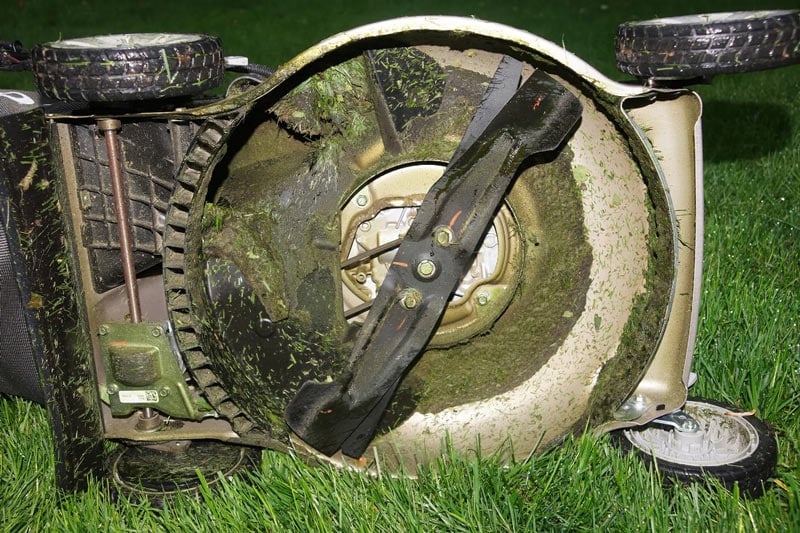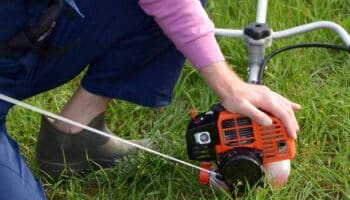Do you have an electric lawn mower, regardless of whether it’s corded or has a battery or two (yes, some come with more than one battery)? If you answered yes, that’s terrific.
Electric mowers are environmentally friendly. If you have a small lawn, they can be cost-effective over time considering the amount of money you’ll save on fuel.
That doesn’t mean you should mow whenever you want, though. Like, when it’s wet outside.
Yes, that’s right. Although your mower may be environmentally sensitive, that doesn’t mean Mother Nature gives you a pass on mixing electricity and water.
Think of it this way; do electricity and water go together? Well, technically, they do. If you’re present, you also become conductive since water and electrolytes make you up.
Water is very conductive of electricity when salt or sugar are present. We’re not talking table salt or simple sugar. More like things like sodium and glucose ions. This means pretty much anything outside of deionized water is going to be conductive.

That also means, that if you’re present where water and electricity are, you have an increased risk of electrical shock. You wouldn’t play with electricity for fun on a dry day. Why risk it on a wet one?
Yet, you may still be curious about using an electric mower on wet grass. Before you do, let’s take a look at six risks and tips before you power up that mower.
1. Always Refer to Your Owner’s or Manufacturers Manual First
Yes, that’s correct. Before getting into anything else, safety always comes first. After all, that is one of the reasons they give you that handy-dandy manual when you acquire a lawn mower.
The manual isn’t only for the manufacturer to protect themselves from legal action. They understand if someone gets hurt using their product, it’s a bad look for them. The warnings in those manuals are to prevent accidents and bad looks. Bad looks are bad for business.
Not following warnings can be bad for you.
In doing a random Google search on a couple of different electric mowers, both corded and battery-powered, the first warning in the associated manuals was pretty much, “Avoid Operating in a Dangerous Environment.”
“Well, what classifies as a dangerous environment?” you may ask.
Glad you did because the answer comes next. “Do not operate the mower in damp or wet locations. Do not operate where you’re unsure of your footing.”
So, they’re not worried about only electricity here. They also don’t want you to slip and lose control of the mower.
“Okay, but my lawn is flat and it’s only sprinkling out. Not a downpour.”
Fair enough. To which the manufacturer now says in the next warning, “Don’t use in the rain.”
That’s it. Nothing else. It even gets its own line item.
So, it’s pretty clear where the manufacturer stands on safety and warning so far.
2. It’s Not Raining but is it Damp?
All right, it’s not raining. Heck, it may even be sunny. Beautiful. Even a nice mild breeze. Perfect weather for mowing, right?
Then you walk out on the lawn and realize it’s damp. Maybe it’s from dew. Perhaps it’s still damp from the rain a couple of days before and it hasn’t been warm enough to dry out. Or maybe you have too much shade and it takes longer to dry naturally.
The point is, your lawn is wet. And wet lawns are not good for mowers, period.
Now you may be saying, “Yeah but the weather’s perfect and I know my electric mower can handle this. It’s safe.”
Okay, if you’re saying that to yourself, then ask yourself the next question.
3. Is It A Corded Mower Or Battery Powered Mower?
This is a really important question because a corded mower, of course, is required to be plugged in while in use. A battery-powered one, on the other hand, needs to be charged.
So, if it’s not raining but the grass is wet, you have to understand there is still a potential for an electric shock when dealing with the corded mower more so than a battery-powered one.
Why is that important to know?
Well, you don’t want to be messing with or dragging around electrical plugs in wet grass. What if your cord isn’t long enough to do your entire lawn and you have to unplug, move the cord, and plug it in again at another outlet somewhere in the yard or add another cord as a jumper? Meanwhile, everything is getting wetter and wetter.
Can you deal with a cord in wet grass? Yes, there’s always a way, especially if it’s a cord that’s double-insulated and in good shape. But even if you have great cords, what if there’s a cut in the cord you don’t see? When was the last time you inspected your cords? Now you may be dealing with something that can easily shock you.
If it’s battery-powered, there’s less of a chance of a shock, even though batteries don’t like moisture either. But, when dealing with anything electrical, there’s always a chance. Yet that’s not the only issue facing battery-powered lawnmowers.
4. The Potential for Equipment Damage
Now, there’s always the risk of potential equipment damage when you’ve decided to mow in wet grass, regardless of the source of power. Wet grass is hard on mower parts.
Think of it this way: have you ever mowed weight grass and noticed how much harder it is to push the mower? How sometimes it will stall? Or do the mower blades get fouled with chunks of turf that have clumped together because of the moisture instead of nice dry individual blades of grass?
What ultimately is happening is the mower is working way harder than it should. This can lead from damaged mower blades to a burned-out motor.
In the case of a battery-powered mower, your battery might not only die. There’s a risk it can blow up if pushed too hard. This is very true if you’re noticing shorter and shorter run times during operation.
But what if that battery keeps burning out without it blowing up? We all know the more you have to charge a battery, the less efficient it becomes. And if you’re recharging your battery three or four times to mow your damp lawn, your battery may die completely. Those batteries are not the cheapest to replace.
If you want to get any replacement part – or see how much one would cost – click to enter your model number in the search bar below. Our partners at AppliancePartsPros stock almost every part with free guides on how to install them.


Also, again, batteries hate moisture. If your battery is exposed to moisture when it doesn’t have to be, it can cause a short. A short can lead to overheating, burn, and a possible breakdown.
5. Is It Damp or Wet?
This should be a pretty easy question to answer in a few minutes’ time. Say it is sunny outside but the grass looks a little damp. Go take a walk on it and check out your shoes. Do they look like they’re picking up moisture? Are they wet like you stepped in a puddle or may have gotten spritzed with a sprinkler?
If it’s the former, it’s too wet to mow. Not only for electrical safety reasons but also because grass that is wet will clump and bog down your mower. If you do try to cut it, you may take hunks of your grass out rather than a nice trim.
Another way to gauge the dampness of your grass is how the ground feels when you walk on it. If it feels squishy then you probably don’t want to mow either. That’s an indication the ground is sodden.
Maybe the grass isn’t that wet in the area you tested so check another part of the lawn where water doesn’t drain as well. It’s more likely to not only be sodden, but visibly wet. Don’t mow.
Lastly, if you’re still not convinced, take your mower out on a dry run. Don’t plug it in or load the battery. Wheel it out and go back and forth on different spots of the lawn. Then look at the grass and see if your mower’s wheels have left tracks. If the tracks look like grass ruts or ditches, your lawn is too wet to mow.
6. Know Your Lawn and Your Equipment
This goes without saying but, unless this is your first time mowing your lawn, you probably have a decent feel for its condition. How wet it is, how dry it is, when the grass needs more watering, when it needs to be left alone to avoid over-mowing and lawn burn, etc.
It sounds cliched but when you’ve spent a while mowing your lawn, you get a knack for the trouble areas and when it’s the best time to mow. It sounds weird but it’s often true. You can usually sense when it’s not a good idea to tackle lawn duty for the day.
Conclusion
When it comes to using an electric mower on wet grass, it’s best to know your manufacturer’s safety recommendations as well as the impact that moisture can have on your equipment. This is why you should always consult your manual or manufacturer’s website before any use.
Also, it’s good to understand why you shouldn’t operate your mower at particular times and the risks involved. A great lawn will always wait for you and the right conditions for some TLC.








